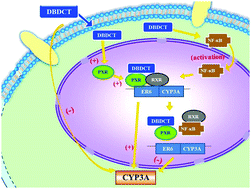Organotin compound DBDCT induces CYP3A suppression through NF-κB-mediated repression of PXR activity
Abstract
Organotin anticancer agent di-n-butyl-di-(4-chlorobenzohydroxamato)tin(IV) (DBDCT) exerted an inhibitory effect on its major metabolic enzyme cytochrome CYP3A. But whether hepatic drug-metabolizing enzymes and their regulatory nuclear receptors including pregnane PXR and constitutive androstane CAR binding with retinoid receptor RXR as a heterodimer are involved in the DBDCT-mediated regulation of CYP3A remains unclear. This study was undertaken to determine the mechanisms responsible for the effects of DBDCT on CYP3A suppression, focusing on the PXR-mediated and NF-κB pathways. The results indicated DBDCT suppressed CYP3A expression by inhibiting CAR expression. But what's interesting is, both protein and mRNA of PXR increased with increasing DBDCT. A further exploration, dual luciferase reporter gene analysis, clarified that DBDCT induced CYP3A expression elevation via the PXR-mediated pathway and this induction was countered by activation of NF-κB, which played a pivotal role in suppression of CYP3A through disrupting the association of the PXR–RXRα complex with DNA sequences by EMSA. PXR-mediated CYP3A expression was similarly demonstrated by RNAi. As expected, expression of CYP3A and its mRNA levels were reduced by DBDCT only in NF-κB(+/+) but not in NF-κB(−/−) cells. The inductive effect of DBDCT on CYP3A4 mRNA was enhanced in PXR shRNA-transfected cells but weakened in the ip65 group, which showed both PXR up-regulated CYP3A expression and NF-κB p65 activation directly contributed to CYP3A inhibition. In conclusion, activated NF-κB by DBDCT interacts directly with the DNA-binding domain of PXR, and disrupts the binding between the PXR–RXR dimer, thereby affecting the regulatory process for CYP3A transcription and, therefore, leading to a decrease of the expression of the PXR-regulated CYP3A.



 Please wait while we load your content...
Please wait while we load your content...